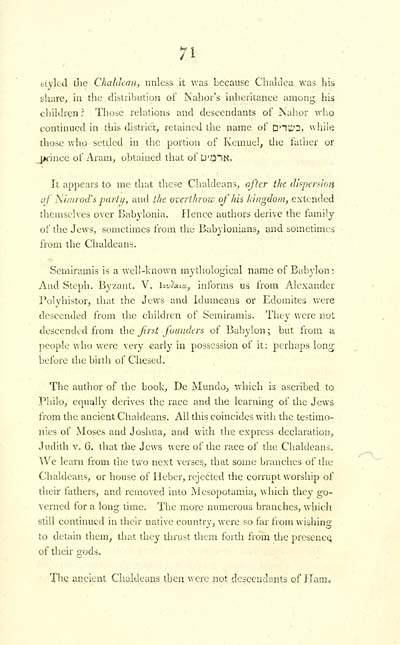Blair Collection > Celtic researches, on the origin, traditions & language, of the ancient Britons
(161)
Download files
Complete book:
Individual page:
Thumbnail gallery: Grid view | List view

tíylcJ the Chaldean, unless it was because Chaldea was his
share, in the distribution ot" Nahor's inheritance among his
cbildrçn ? Those rehitions and descendants ot" isaiior who
continued in this district, retained the name of D'ltii'D, while
those who settled in the portion of Kerauel, the father or
j>iince of Aram, obtained that of U'QIK.
It appears to me that these Chaldeans, after the dhpemor}
a/ Ν im rod's part I/, and the overthrow of his kingdom, extended
themselves over Babylonia. Hence authors derive the family
of the Jews, sometimes from the Babylonians, and sometimes
irom the Chaldeans.
Semiramis is a well-known mythological name of Babylon:
And Stcph. Byzant. V. U'Jxta, informs us from Alexander
Polyhistor, that the Jews and idumeans or Edomites were
descended from the children of Semiramis. They were not
descended from the first founders of Babylon ; but from a,
people who were very early in possession of it: perhaps long
before the birth of Chesed.
The author of the book, De Mando, which is ascribed to
Philo, equally derives the race and the learning of the Jews
from the ancient Chaldeans. All this coincides with the testimo-
nies of Moses and Joshua, and with the express declaration,
Judith V. 6. that the Jews were of the race of the Chaldeans.
We learn from the two next verses, that some branches of the
Chaldeans, or house of licber, rejected the corrupt worship of
their fathers, and removed into Mesopotamia, which they go-
verned for a long time. The more numerous branches, which
still continued in their native country, were so far from wishing
to detain them, that they thrust them Ibrth from the presence
of their gods.
The ancient Chaldeans then were not descendants of Ham,
share, in the distribution ot" Nahor's inheritance among his
cbildrçn ? Those rehitions and descendants ot" isaiior who
continued in this district, retained the name of D'ltii'D, while
those who settled in the portion of Kerauel, the father or
j>iince of Aram, obtained that of U'QIK.
It appears to me that these Chaldeans, after the dhpemor}
a/ Ν im rod's part I/, and the overthrow of his kingdom, extended
themselves over Babylonia. Hence authors derive the family
of the Jews, sometimes from the Babylonians, and sometimes
irom the Chaldeans.
Semiramis is a well-known mythological name of Babylon:
And Stcph. Byzant. V. U'Jxta, informs us from Alexander
Polyhistor, that the Jews and idumeans or Edomites were
descended from the children of Semiramis. They were not
descended from the first founders of Babylon ; but from a,
people who were very early in possession of it: perhaps long
before the birth of Chesed.
The author of the book, De Mando, which is ascribed to
Philo, equally derives the race and the learning of the Jews
from the ancient Chaldeans. All this coincides with the testimo-
nies of Moses and Joshua, and with the express declaration,
Judith V. 6. that the Jews were of the race of the Chaldeans.
We learn from the two next verses, that some branches of the
Chaldeans, or house of licber, rejected the corrupt worship of
their fathers, and removed into Mesopotamia, which they go-
verned for a long time. The more numerous branches, which
still continued in their native country, were so far from wishing
to detain them, that they thrust them Ibrth from the presence
of their gods.
The ancient Chaldeans then were not descendants of Ham,
Set display mode to: Large image | Transcription
Images and transcriptions on this page, including medium image downloads, may be used under the Creative Commons Attribution 4.0 International Licence unless otherwise stated. ![]()
| Early Gaelic Book Collections > Blair Collection > Celtic researches, on the origin, traditions & language, of the ancient Britons > (161) |
|---|
| Permanent URL | https://digital.nls.uk/75765651 |
|---|
| Description | A selection of books from a collection of more than 500 titles, mostly on religious and literary topics. Also includes some material dealing with other Celtic languages and societies. Collection created towards the end of the 19th century by Lady Evelyn Stewart Murray. |
|---|
| Description | Selected items from five 'Special and Named Printed Collections'. Includes books in Gaelic and other Celtic languages, works about the Gaels, their languages, literature, culture and history. |
|---|

